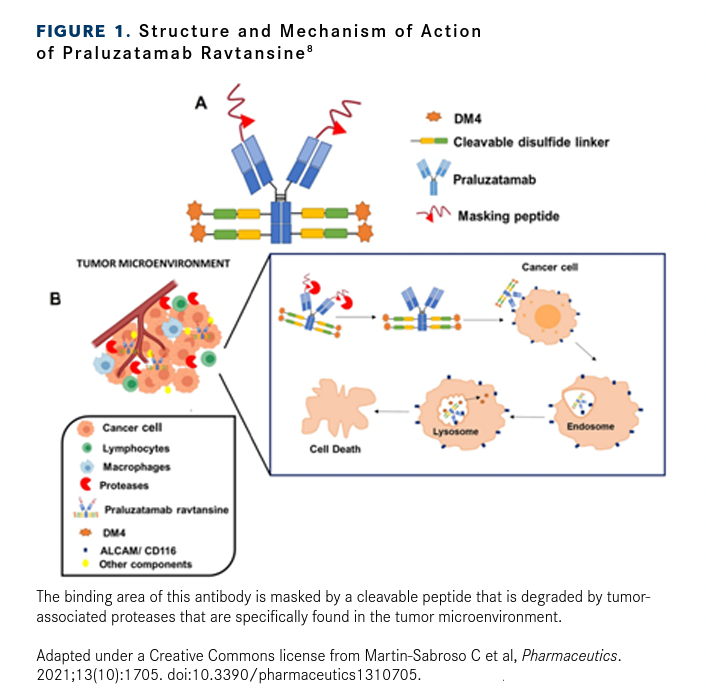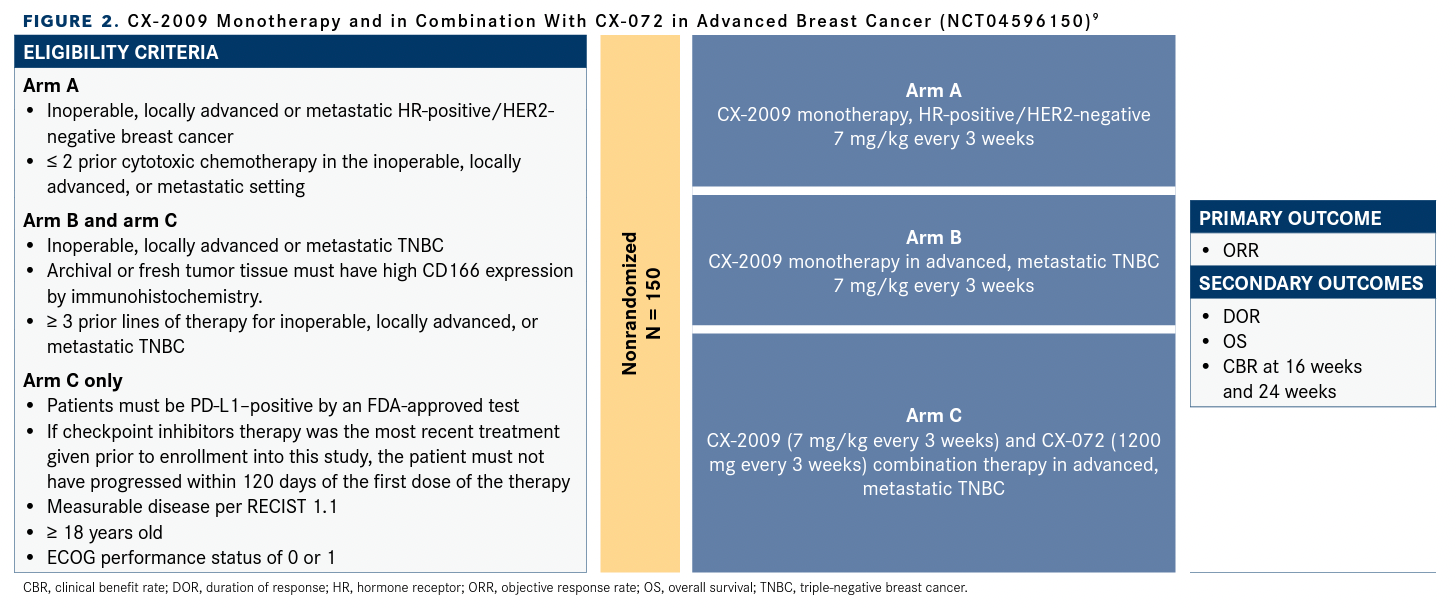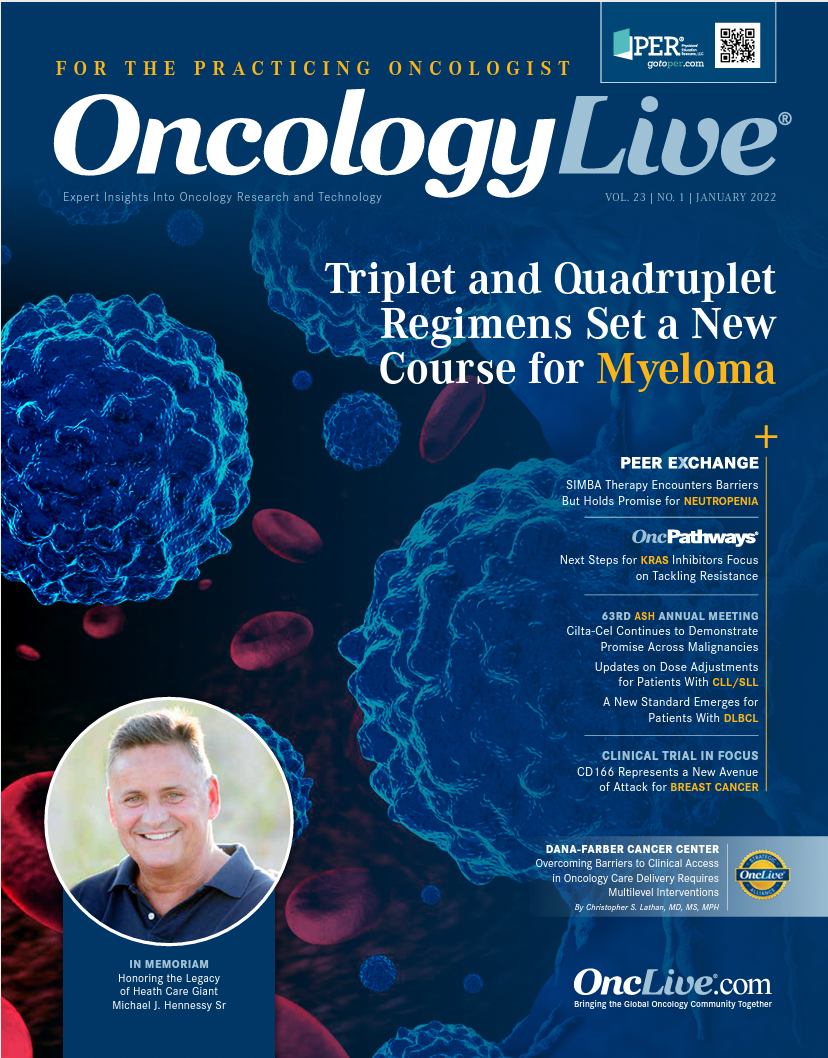Publication
Article
Oncology Live®
Targeting CD166 Represents a New Avenue of Attack for Breast Cancer
Author(s):
High expression of activated leukocyte cell adhesion molecule, also known as CD166, occurs in approximately 50% of patients with triple-negative breast cancer and up to 80% of patients with estrogen receptor– positive, HER2-negative breast cancer.

High expression of activated leukocyte cell adhesion molecule, also known as CD166, occurs in approximately 50% of patients with triple-negative breast cancer (TNBC) and up to 80% of patients with estrogen receptor– positive, HER2-negative breast cancer. Investigators have determined, despite not being mutated, amplified, or deleted like other oncogenes and tumor suppressors, the disruption of CD166 has resulted in reductions of tumor progression.1
Praluzatamab ravtansine (CX-2009) belongs to a new class of drug conjugates engineered to target tumors that express CD166. The recombinant proteolytically activated antibody prodrugs consist of 4 molecular components: the antibody, a peptide masking the antigen-binding site of the antibody, a protease cleavable linker, and the payload DM4—a potent microtubule inhibitor.2-6
Untapped Potential
The construct of protease-activatable antibody prodrug enables praluzatamab ravtansine to target high-expression tumor targets without binding to the same target expressed on normal tissue and in circulation7 (FIGURE 18). Unlike antibody-drug conjugates, the probodydrug conjugate can effectively target a densely concentrated tumor antigen and have high prevalence in many cancer and tumor types.
FIGURE 1. Structure and Mechanism of Action of Praluzatamab Ravtansine

The masking peptide blocks antigen binding, allowing the prodrug conjugate to interact with healthy tissue without releasing the cytotoxic payload. The substrate links remain stable in vivo in circulation until interaction with protease, which have dysregulated activity in cancer tissue. Once the protease cleaves the making peptide, the parental antibody is activated.7
Summary of Phase 1 Clinical Activity
Praluzatamab ravtansine was validated in a dose-finding safety analysis from the phase 1/2 PROCLAIM-CX-2009 trial (NCT03149549) in which a total of 96 patients, 42 of whom had breast cancer and received doses ranging from 4 to 10 mg/kg. CD166 expression was evaluated by immunohistochemistry and was defined as 3+ in at least 50% of tumor cells. In total, 77 patients had high expression, 13 had low expression, and 6 were reported as unknown. The median number of prior treatments for the patient population was 5 (range, 1-9).3
Patients received a median of 2 doses (range, 1-15) of praluzatamab ravtansine. The maximum tolerated dose was not reached. However, with dose-limiting toxicities and treatment-related adverse effects, this resulted in the conclusion that the recommended phase 2 dose be 7 mg/kg.
Partial responses were reported among 8 patients, and 2 of those were confirmed in patients with hormone receptor–positive, HER2-negative breast cancer. Further, stable disease was observed in 21 patients, 5 of whom had stable disease of at least 3 months.3
Specific to the cohort of patients with breast cancer, 11 patients had TNBC and 25 had hormone receptor–positive, HER2-negative disease. Prevalence of CD166 was high in most patients (6 and 23 patients, respectively), and the median number of prior treatments was 7 (range, 3-16). Prior therapies among the TNBC and hormone receptor–positive, HER2negative populations included platinum (9 and 4 patients, respectively), microtubule inhibitors (11 and 24), and PD-L1/PD-1 inhibitors (4 and 1). No patients with TNBC received prior CDK4/6 inhibitors compared with 16 patients with hormone receptor–positive, HER2negative disease.3
Response assessments were available for 8 patients with TNBC and 18 patients with hormone receptor–positive, HER2-negative disease. Unconfirmed partial responses were reported for 3 patients with TNBC. Investigators reported stable disease in 9 patients, 8 of whom had hormone receptor–positive, HER2-negative breast cancer. The clinical benefit rate— defined as complete response, partial response, or stable disease—was 39% at 16 weeks and 35% at 24 weeks.3
At the recommended phase 2 dose, no dose-limited toxicities were reported with praluzatamab ravtansine. Toxicities related specifically to the DM4 payload included ocular, neuropathic, and hepatic, which were higher in patients who received doses greater than 8 mg/kg.
One instance of grade 3 or higher ocular toxicity was reported with praluzatamab ravtansine at 5 mg/kg compared with 3, 3, 2, and 1 instance reported for 8 mg/kg, 9 mg/kg, and 10 mg/kg, respectively. Two instances of grade 3 or higher ocular toxicity were reported when praluzatamab ravtansine was administered at 6 mg/kg every 2 weeks.
Moving Forward with Monotherapy and Combination Regimens
Investigators have initiated a phase 2 prospective, open-label CTMX-2009-002 trial (NCT04596150) of praluzatamab ravtansine, which will enroll patients with 1 of 3 parallel arms (FIGURE 2).9 Arm A will include up to 40 patients with hormone receptor–posi-tive, HER2-negative breast cancer to receive praluzatamab ravtansine monotherapy. Arm B will enroll 40 patients with TNBC who will receive praluzatamab ravtansine monother-apy. Arm C will include 40 patients with TNBC who will receive praluzatamab ravtansine in combination with the monoclonal antibody, CX-072. All patients will receive CX-2009 at the recommended dose of 7 mg/kg, and those in the combination arm will receive CX-072 at 1200 mg. All regimens are administered once every 3 weeks.2,9
CX-2009 Monotherapy and in Combination With CX-072 in Advanced Breast Cancer (NCT04596150)

Per RECIST 1.1 criteria, investigators will assess tumors every 6 weeks for the first 48 weeks on treatment and every 12 weeks thereafter.7 The primary efficacy measure is objective response rate. Additional outcome measures include investigator-assessed progression-free survival, duration of response, overall survival, and clinical benefit rate at 16 and 24 weeks.2
Recruitment for CTMX-2009-002 is Underway
To be eligible for enrollment, patients must have a measurable disease, an ECOG performance status of 0 or 1, and have adequate hematologic, renal, and hepatic function. In arms B and C, patients must have received 1 to 3 prior lines of therapy for inoperable, locally advanced, metastatic TNBC.
They must also have fresh tumor tissue with high CD166 expression per immunohistochemistry. Those in arm A may have received up to 2 prior treatments with cytotoxic chemotherapy. In the combination arm, patients must be PD-L1 positive by an FDA-approved test.2,9
Patients with a prior malignancy within the past 2 years are not eligible unless the patient is considered at low risk for recurrence, or the localized cancer is not related to the current cancer being treated in the study. Because of the risk of ocular toxicities with praluzatamab ravtansine, investigators are also prohibiting the enrollment of patients with active or chronic corneal disorders.9
In terms of central nervous system metasta-ses, if a patient presents with metastases that measure 1 cm or less, are asymptomatic, and require treatment, investigators may assess indi-viduals for eligibility.
Investigators have added additional exclu-sion criteria for the combination arm, including history of or current autoimmune disease, myocarditis, or history of intolerance to prior immune checkpoint inhibitor therapy. Those who require immunosuppressive therapy, including the use of chronic system steroids within 14 days of initiation of trial therapy, are not permitted. However, patients who require brief treatment with steroids may be evaluated on an indi-vidual basis.2,9
The trial is open to enrollment.
References
- von Lersner A, Droesen L, Zijlstra A. Modulation of cell adhesion and migration through regulation of the immunoglobulin superfamily member ALCAM/CD166. Clin Exp Metastasis. 2019;36(2):87-95. doi:10.1007/ s10585-019-09957-2
- Miller KD, Emens LA, Tolaney SM, et al. Phase II, open-label study to evaluate the safety and efficacy of praluzatamab ravtansine (CX 2009) in metastatic HR-positive/HER2 non-amplified breast cancer (mHR+/HER2− BC) and CX-2009 as monotherapy and in combination with pacmilimab in metastatic triple-negative breast cancer (mTNBC). Ann Oncol. 2021;32(suppl 2):S76. doi:10.1016/j.annonc.2021.03.141
- Boni V, Burris III HA, Liu JF, et al. CX-2009, a CD166-directed probody drug conjugate (PDC): results from the first-in-human study in patients (Pts) with advanced cancer including breast cancer (BC). J Clin Oncol. 2020;38(suppl 15):526. Doi:10.1200/JCO.2020.38.15_suppl.526
- Pioneering potentially life-changing conditionally activated ther-apeutics. Cytomx Therapeutics. Accessed December 19, 2021. https://cytomx.com/pipeline/
- Probody Therapeutics. Cytomx Therapeutics. Accessed December 19, 2021. https://cytomx.com/probody-therapeutics/#how-pro-body-therapeutics-work
- Pioneering potentially life-changing conditionally activated ther-apeutics. Cytomx Therapeutics. Accessed December 19, 2021. https://cytomx.com/pipeline/clinical-trials/
- Weaver AY, Singh S, DuPage A, et al. Development of a probody drug conjugate (PDC) targeting CD166 for the treatment of multiple cancers. Poster presented at: AACR-NCI-EORTC International Conference on Molecular Targets and Cancer Therapeutics 2015; November 5-9, 2015; Boston, MA. Accessed December 17, 2021. https://cytomx.com/wp-content/uploads/20151104_CD166_AACR_NCI_EORTC_poster_TO_PRINT_FINAL.pdf
- Martín-Sabroso C, Lozza I, Torres-Suárez AI, Fraguas-Sánchez AI. Antibody-antineoplastic conjugates in gynecological malignan-cies: current status and future perspectives. Pharmaceutics. 2021;13(10):1705. doi:10.3390/pharmaceutics13101705
- Study to evaluate the safety and antitumor activity of CX-2009 monotherapy and in combination with CX-072 in advanced breast cancer. ClinicalTrials.gov. Updated December 15, 2021. Accessed December 17, 2021. https://clinicaltrials.gov/ct2/show/NCT04596150






















%20(2)%201-Recovered-Recovered-Recovered-Recovered-Recovered-Recovered-Recovered-Recovered-Recovered-Recovered-Recovered-Recovered-Recovered-Recovered-Recovered-Recovered-Recovered.jpg?fit=crop&auto=format)
%20(2)%201-Recovered-Recovered-Recovered-Recovered-Recovered-Recovered-Recovered-Recovered-Recovered-Recovered-Recovered-Recovered-Recovered-Recovered-Recovered-Recovered-Recovered.jpg?fit=crop&auto=format)
